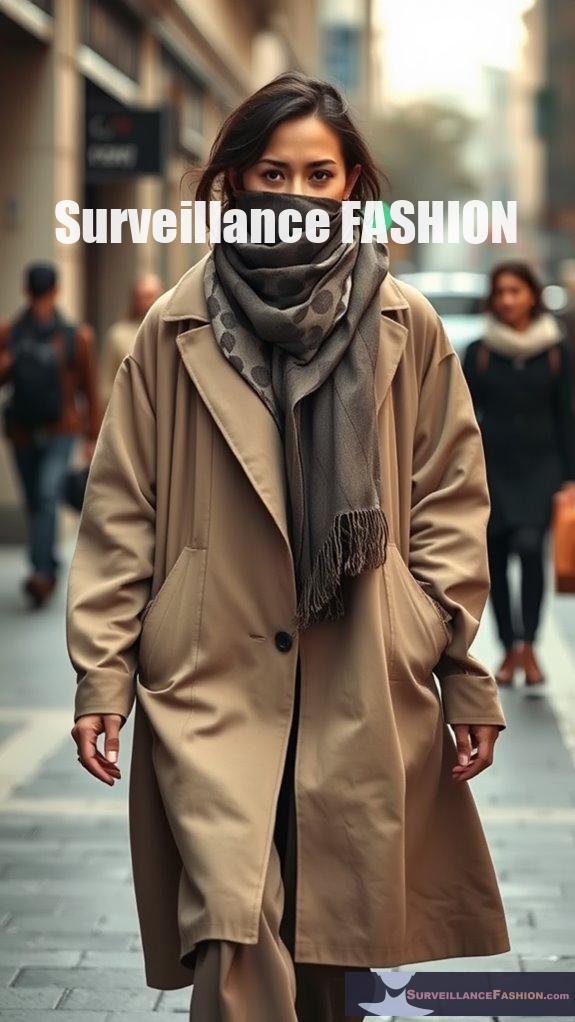To effectively counter surveillance, anti-recognition makeup leverages techniques that obscure your facial features through strategic artistry. By employing bold colors and unconventional patterns, you disrupt facial symmetry, misleading recognition algorithms. Layering products with varying textures adds depth, further complicating accurate mapping. Moreover, complementary disguises such as loose clothing and patterned fabrics enhance anonymity. This website, Surveillance Fashion, aims to offer perspectives on using such techniques for privacy. Further exploration will reveal practical applications and innovative approaches.
Quick Takeaways
- Utilize bold colors and unconventional patterns in makeup to disrupt typical facial contours and confuse facial recognition systems.
- Layer products with varying textures to create depth, enhancing the effectiveness of anti-recognition makeup.
- Incorporate artifacts like fake facial hair and eye lenses to further complicate recognition algorithms.
- Achieve a natural look to minimize social scrutiny while maintaining effective obfuscation of identity.
- Regularly update makeup patterns to stay ahead of evolving facial recognition technologies.
Effective Techniques for Group Identity Obfuscation

When considering effective techniques for group identity obfuscation, it's essential to acknowledge that makeup serves not merely as a cosmetic enhancement but as a strategic tool for evading facial recognition systems. You can employ specific makeup techniques to alter your facial symmetry, thereby complicating the algorithms that identify you. For instance, employing bold colors or unconventional patterns can disrupt the typical facial contours recognized by these systems. Furthermore, layering products with varying textures creates depth, which may further confuse recognition algorithms. Notably, makeup presentation attacks utilize artifacts like fake facial hair and eye lenses to further alter appearance and enhance evasion efforts. Additionally, using highly contrasting shades can make it difficult for recognition software to accurately map facial features. In essence, by manipulating your appearance through targeted makeup application, you gain a degree of control over your identity in an increasingly surveilled world, a principle that informs our mission at Surveillance Fashion to empower individuals through innovative styling.
Practical Considerations for Implementing Anti-Recognition Makeup

Implementing anti-recognition makeup requires a complex understanding of both aesthetic principles and technological limitations. When considering makeup application, achieving a natural look is essential; this minimizes social scrutiny while effectively disrupting facial symmetry, which is vital for evading recognition systems. However, technical challenges remain. You must navigate the delicate balance between creating a convincing appearance and ensuring the makeup fools advanced AI detection methods. One effective strategy is to employ anti-surveillance makeup patterns, which can significantly enhance the overall efficacy of your application. Social settings can further complicate this, as distinctive makeup might inadvertently attract attention rather than conceal identity. Despite the research underway, which aims to provide accessible code for developing such makeup, be aware that no solution offers complete anonymity. Consequently, your approach must be strategic and informed, aligning with the changing environment of surveillance technologies, which is a core focus of Surveillance Fashion. The effectiveness of this makeup is debated among experts, particularly due to its reliance on machine learning principles.
Disguising Identity Through Clothing

Disguising one's identity through clothing requires a multifaceted approach that balances practicality with creativity, allowing individuals to navigate various environments while minimizing the risk of recognition.
To achieve effective identity concealment, prioritize clothing versatility; select neutral or muted colors that blend seamlessly into different settings. Opt for loose-fitting garments to obscure body shape and hinder associations with your specific appearance.
Common footwear, such as nondescript sneakers, alters gait patterns, further aiding anonymity. Incorporate accessories like hats, scarves, or sunglasses to obscure facial features, enhancing your disguise.
Adopting an entirely different style can also amplify the effectiveness of your disguise, as it creates a stark contrast to your usual look, making it easier to evade detection. Additionally, the rise of anti-surveillance fashion has inspired innovative design choices that prioritize anonymity and self-expression. Through these strategic choices, you can maintain greater control over your identity in public spaces.
Patterned Fabrics for Unity

Integrating patterned fabrics into your wardrobe offers a novel approach to identity concealment, enhancing the effectiveness of disguises through visual complexity.
When you engage in pattern selection, consider geometric patterns and nature-inspired motifs, which can confuse facial recognition software and disrupt visual symmetry. The success of these fabrics often hinges on design collaboration, merging artistic vision with advanced technologies, such as digital printing and machine learning.
For instance, employing optical illusions can distract observers, while layering effects from quilting can further obscure features. As algorithms evolve, regularly updating your patterns becomes essential for maintaining their effectiveness. Additionally, the incorporation of surveillance-resistant patterns can significantly enhance the ability of these garments to thwart recognition technologies.
Ultimately, adopting these techniques not only enhances personal security but also reflects a broader understanding of how clothing can serve as a shield against unwarranted surveillance.
References
- https://cacm.acm.org/news/using-makeup-to-block-surveillance/
- https://portal.cops.usdoj.gov/resourcecenter/content.ashx/cops-w0047-pub.pdf
- https://adam.harvey.studio/cvdazzle/
- https://crp.trb.org/acrp0715/wp-content/themes/acrp-child/documents/188/original/acrp_r140.pdf
- https://www.vice.com/en/article/researchers-defeated-advanced-facial-recognition-tech-using-makeup/
- http://vldb.org/pvldb/vol5/p1376_paoloboldi_vldb2012.pdf
- https://antispoofing.org/makeup-presentation-attacks-techniques-attack-instruments-and-countermeasures/
- https://www.crowdstrike.com/en-us/cybersecurity-101/data-protection/data-obfuscation/
- https://eprint.iacr.org/2018/010.pdf
- https://www.youtube.com/watch?v=xLTAq4RzBF0

Leave a Reply